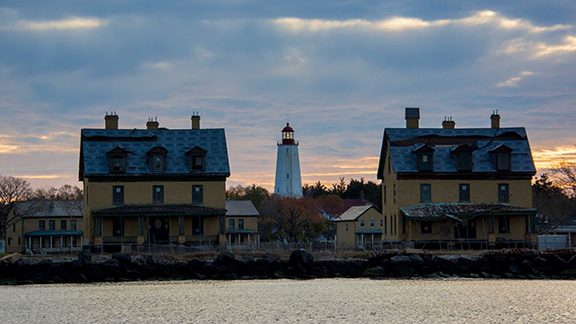
By Sunayana Prabhu
FORT HANCOCK – A severe lack of funds might put the brakes on the historic renovation of Fort Hancock’s Officers’ Row buildings.
Rehabilitating the 21 buildings on the Sandy Hook peninsula – to the state’s historic restoration standards – for long-term residential use will cost the National Park Service (NPS) an estimated $100 million, Jennifer Nersesian, superintendent of Gateway National Recreation Area told the Fort Hancock 21st Century Federal Advisory Committee (FACA) during its Nov. 6 virtual public meeting.
“This project is upside down,” Nersesian said. The New York-based Stillman Development Group has provided the financial analysis using two “pilot” Officer’s Row buildings to create an estimate for the 21 similar buildings. Of the $100 million, the Stillman group is willing to invest $50 million; the NPS is on the hook to fund the remaining amount.
“Just the break-even point is about a $50 million investment” for any private investor, Nersesian told FACA members. “We have a large financing gap by their (Stillman’s) estimates,” she said.
Around three years ago, just as the COVID-19 pandemic began, the NPS entered into a general agreement with Stillman to rehabilitate 23 Officers’ Row buildings for long-term residential use, considered the most economically viable business model to revitalize the area. But the costs have now escalated. The steady deterioration of the buildings and post-pandemic supply chain delays were cited as primary reasons for the increasing costs.
Roy Stillman, president of Stillman Development International, presented detailed prototypes for two Officers’ Row buildings at the FACA meeting in May. These two pilot buildings served as the basis for estimates for every design subcomponent and the construction work planned for the remaining houses.
The cost for rehabilitation versus the potential for return on investment in the marketplace is a “big, daunting gap,” Nersesian told the committee and, although it is not “a hard and fast number,” she said, “it gives us a sense of scale, at least a $50 million gap that needs to be addressed in order for there to be a viable leasing project here from a private investment perspective.”
To offset some of the costs and stem the deterioration of the buildings, the NPS has been making some phased investments, including installing new roofs on the Officers’ Row buildings at a cost to the NPS of over $3 million. However, “$50 million isn’t the kind of money that the Park Service usually has to put it into projects,” Nersesian said, even under the Great American Outdoors Act, which she said has already brought in “larger chunks of money for deferred maintenance than we have ever seen before.”
The Sandy Hook Foundation, a philanthropic partner at Sandy Hook, has suggested solutions for bridging the financial gap by using government, private and charitable investments to reach $50 million.
FACA member Mary Eileen Fouratt questioned whether the project could receive American Rescue Plan Act (ARPA) funds from the county or the town for the project. Anthony Mercantante, Middletown Township administrator, also part of FACA, said ARPA funds were allocated to towns as a direct response to deficits in the town’s budgets due to the pandemic. The funds the town and even the county get “are not going to put a major dent in what’s needed here,” he said.
Mercantante said his office needs to “reengage” with U.S. Rep. Frank Pallone Jr. (D-6) about his concerns over the “whole concept of privatizing public buildings and parks.”
“Unless you can come up with a substantial amount of money to step in and restore and rehabilitate these buildings, there is no other option other than private investment,” he said.
Since federal agencies are not permitted to advocate for funding, a new working committee to explore funding opportunities for the NPS was formed at the Thursday meeting. FACA is comprised of experts from several disciplines and occupations, drawn mainly from the communities surrounding Sandy Hook, to make recommendations for the preservation and adaptive reuse of over 30 National Historic Landmark structures under the National Park Service’s historic property leasing program authority.
FACA has had a few successes with restoring and leasing properties in recent years. Buildings 56 and 23, part of a $12 million project funded by Monmouth County, are being leased by the Marine Academy of Science and Technology (MAST).
According to the NPS’s leasing updates, several other buildings are now open. Building 36 is now the Mule Barn Tavern, an upscale pub and event space. Building 53 is being used as a café, Buildings 52 and 21 are used for lodging, and Building 104 is being used as an office. Lease negotiations are nearly completed for Buildings 24 and 25, authorized for residential use; Building 40, a former YMCA, will soon be a restaurant, and Building 114, the Officers’ Club, will be used for events, lodging and outdoor dining.
FACA has been meeting about rehabilitating Fort Hancock properties for over a decade; the Thursday meeting was their 42nd. Although it has had some successes, the Officers’ Row buildings are proving to be a challenge. “But we are still committed to the preservation of these buildings,” said Nersesian.
This article originally appeared in the November 16 – 22, 2023 print edition of The Two River Times.














